Related Research Articles
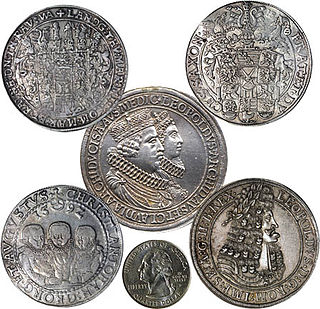
A thaler or taler is one of the large silver coins minted in the states and territories of the Holy Roman Empire and the Habsburg monarchy during the Early Modern period. A thaler size silver coin has a diameter of about 40 mm and a weight of about 25 to 30 grams. The word is shortened from Joachimsthaler, the original thaler coin minted in Joachimsthal, Bohemia, from 1520.

The svenska riksdaler was the name of a Swedish coin first minted in 1604. Between 1777 and 1873, it was the currency of Sweden. The daler, like the dollar, was named after the German Thaler. The similarly named Reichsthaler, rijksdaalder, and rigsdaler were used in Germany and Austria-Hungary, the Netherlands, and Denmark-Norway, respectively. Riksdaler is still used as a colloquial term for krona, Sweden's modern-day currency.

The mark was a currency or unit of account in many states. It is named for the mark unit of weight. The word mark comes from a merging of three Germanic words, Latinised in 9th-century post-classical Latin as marca, marcha, marha or marcus. It was a measure of weight mainly for gold and silver, commonly used throughout Europe and often equivalent to 8 troy ounces (250 g). Considerable variations, however, occurred throughout the Middle Ages.

The Maria Theresa thaler (MTT) is a silver bullion coin and a type of Conventionsthaler that has been used in world trade continuously since it was first minted in 1741. It is named after Maria Theresa who ruled Austria, Hungary, and Bohemia from 1740 to 1780 and is depicted on the coin.
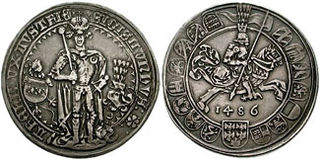
The Guldengroschen or Guldiner was a large silver coin originally minted in Tirol in 1486, but which was introduced into the Duchy of Saxony in 1500.

The Conventionstaler or Konventionstaler, was a standard silver coin in the Austrian Empire and the southern German states of the Holy Roman Empire from the mid-18th to early 19th-centuries. Its most famous example is the Maria Theresa thaler which is still minted today. The Conventionsgulden was equivalent to a 1⁄2Conventionsthaler.

The Reichsthaler, or more specifically the Reichsthaler specie, was a standard thaler silver coin introduced by the Holy Roman Empire in 1566 for use in all German states, minted in various versions for the next 300 years, and containing 25–26 grams fine silver.

The rigsdaler was the name of several currencies used in Denmark until 1875. The similarly named Reichsthaler, riksdaler and rijksdaalder were used in Germany and Austria-Hungary, Sweden and the Netherlands, respectively. These currencies were often anglicized as rix-dollar or rixdollar.

The Austro-Hungarian gulden was the currency of the lands of the House of Habsburg between 1754 and 1892, when it was replaced by the Austro-Hungarian krone as part of the introduction of the gold standard. In Austria, the gulden was initially divided into 60 kreuzers. The currency was decimalized in 1857, using the same names for the unit and subunit.
The South German Gulden was the currency of the states of Southern Germany between 1754 and 1873. These states included Bavaria, Baden, Württemberg, Frankfurt and Hohenzollern. It was divided into 60 kreuzer, with each kreuzer worth 4 pfennig or 8 heller.
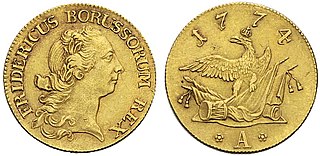
The Thaler was the currency of the Free Hanseatic City of Bremen until 1873, when Germany adopted the gold mark (ℳ). It was divided into 72 Grote, each of 5 Schwaren. While initially identical to the North German thaler before the 1750s, it was the only currency to maintain the gold standard of 5 thalers to a Friedrich d'or pistole from the 1750s until 1873, long after all other states adopted the Conventionsthaler.
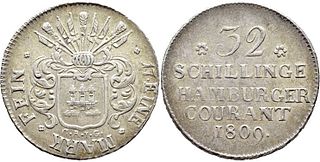
The Hamburg Mark refers to two distinct currencies issued in the city of Hamburg until 1875:
The Prussian Thaler was the currency of Prussia until 1857. In 1750, Johann Philipp Graumann implemented the Graumannscher Fuß with 14 thalers issued to a Cologne Mark of fine silver, or 16.704 g per thaler.
The Thaler was a coin issued by Baden of varying equivalents to its currency, the South German gulden, each of 60 kreuzer. Beginning in 1690, the Reichsthaler specie coin of 25.984 g fine silver was issued for 2 gulden. After 1754, the Conventionsthaler of 23.3856 g fine silver was issued for 2.4 gulden. Starting in the 19th, century the Kronenthaler of 25.71 g fine silver was issued for 2.7 gulden ; the French silver écu also started being accepted for 2.8 gulden. After 1837, the doppelthaler, which was worth two Prussian thalers, was issued for 31⁄2 gulden. From 1857 to 1871, the Vereinsthaler was issued for 13⁄4 gulden.

The rigsdaler specie was a unit of silver currency used in Norway from 1544, renamed as the speciedaler in 1816 and used until 1873. Norway used a common reichsthaler currency system shared with Denmark, Hamburg and Schleswig-Holstein until 1873 when the gold standard was implemented in Scandinavia and the German Empire.

The Hamburger Bank was a public credit institution founded in 1619 by the Free City of Hamburg. It operated independently until 31 December 1875, when it became part of the newly created Reichsbank.
The North German thaler was a currency used by several states of Northern Germany from 1690 to 1873, first under the Holy Roman Empire, then by the German Confederation. Originally equal to the Reichsthaler specie or silver coin from 1566 until the Kipper und Wipper crisis of 1618, a thaler currency unit worth less than the Reichsthaler specie was first defined in 1667 and became widely used after adoption of the Leipzig currency standard of 1690.
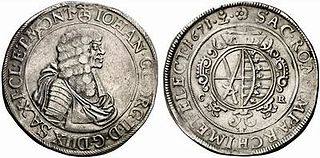
The Wechselthaler, also spelt Wechseltaler or Wechsel-Thaler, was minted in 1670 and 1671 in the Electorate of Saxony under Elector John George II (1656–1680) to the Wechselthaler or Burgundian thaler standard (861/1000 fineness). As the name suggests, the Wechselthaler and its subdivisions were intended as a currency to encourage Leipzig's trade with Hamburg and the Netherlands. The first coins from 1670 therefore bear the inscription WECHSELTHALER on the reverse. The Wechselthaler standard was only valid in Electoral Saxony in 1670 and 1671.
A Münzfuß is an historical term, used especially in the Holy Roman Empire, for an official minting or coinage standard that determines how many coins of a given type were to be struck from a specified unit of weight of precious metal. The Münzfuß, or Fuß ("foot") for short in numismatics, determined a coin's fineness, i.e. how much of a precious metal it would contain. Mintmaster Julian Eberhard Volckmar Claus defined the standard in his 1753 work, Kurzgefaßte Anleitung zum Probieren und Münzen, as follows: "The appropriate proportion of metals and the weight of the coin, measured according to their internal and external worth, or determined according to their quality, additives and fineness, number and weight, is called the Münzfuß."

The schilling was the name of a coin in various historical European states and which gave its name to the English shilling. The schilling was a former currency in many of the German-speaking states of the Holy Roman Empire, including the Hanseatic city states of Hamburg and Lübeck, the March of Brandenburg, and the Duchies of Bavaria, Mecklenburg, and Württemberg. It was also used in Switzerland and in Austria, where silver schillings were introduced as recently as 1923.
References
- ↑ "Species". Archived from the original on 24 November 2007. Retrieved 24 May 2022.
{{cite web}}: CS1 maint: bot: original URL status unknown (link) - ↑ kruenitz1.uni-trier.de
- ↑ Meyers Großes Konversations-Lexikon, Volume 18. Leipzig 1909, p. 724. (online), retrieved 17 September 2013.
- ↑ Pierer's Universal-Lexikon, Vol.16. Altenburg 1863, p. 510– 511 (online), retrieved 17 September 2013.
- ↑ Jäger (1971), pp. 80–116.
